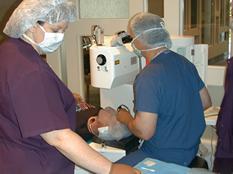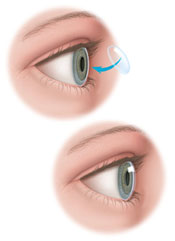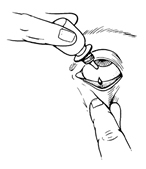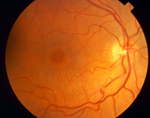

 Conductive Keratoplasty, or CK, is a safe, non-laser, non-cutting technique approved by the FDA to reduce or eliminate presbyopia or hyperopia for patients over 40. Instead of a scalpel or a laser, CK releases radiofrequency (RF) energy through a probe as thin as a strand of human hair, treating your vision condition without cutting or removing tissue. The controlled release of RF energy in a circular pattern shrinks connective tissue in the cornea to reshape it, improving the way the eye focuses light.
Conductive Keratoplasty, or CK, is a safe, non-laser, non-cutting technique approved by the FDA to reduce or eliminate presbyopia or hyperopia for patients over 40. Instead of a scalpel or a laser, CK releases radiofrequency (RF) energy through a probe as thin as a strand of human hair, treating your vision condition without cutting or removing tissue. The controlled release of RF energy in a circular pattern shrinks connective tissue in the cornea to reshape it, improving the way the eye focuses light.
CK was the first FDA-approved method for treating hyperopia. It is safer and less invasive than the LASIK procedure and avoids the complications associated with LASIK treatment such as dry eyes, hazy vision, light sensitivity or poor quality of vision. It takes less than five minutes per eye and uses only a topical anesthetic. Post-operative discomfort is minimal and vision improves almost immediately.
 The cornea is the clear covering of the front of the eye which bends, or refracts, light rays as they enter the eye. For clear vision to occur, the cornea must have the correct shape and clarity to focus incoming light rays precisely on the retina at the back of the eye. When the cornea becomes cloudy or misshapen from injury, infection or disease, transplantation may be recommended to replace it.
The cornea is the clear covering of the front of the eye which bends, or refracts, light rays as they enter the eye. For clear vision to occur, the cornea must have the correct shape and clarity to focus incoming light rays precisely on the retina at the back of the eye. When the cornea becomes cloudy or misshapen from injury, infection or disease, transplantation may be recommended to replace it.
Corneal transplants are usually performed with local anesthesia so there is no pain. During the procedure, the cornea is replaced with one from a human donor. The new cornea carries little risk of rejection and can last for many years.
 Dry eye occurs when the eyes aren't sufficiently moisturized, leading to itching, redness and pain from dry spots on the surface of the eye. The eyes may become dry and irritated because the tear ducts don't produce enough tears, or because the tears themselves have a chemical imbalance.
Dry eye occurs when the eyes aren't sufficiently moisturized, leading to itching, redness and pain from dry spots on the surface of the eye. The eyes may become dry and irritated because the tear ducts don't produce enough tears, or because the tears themselves have a chemical imbalance.
People usually begin experiencing dry eye symptoms as they age, but the condition can also result from certain medications, conditions or injuries.
Dry eye is not only painful, it can also damage the eye's tissues and impair vision. Fortunately, many treatment options are available.
Non-surgical treatments for dry eye include blinking exercises, increasing humidity at home or work, and use of artificial tears or moisturizing ointment. If these methods fail, small punctal plugs may be inserted in the corners of the eyes to limit tear drainage, or the drainage tubes in the eyes may be surgically closed. Eyelid surgery is also a solution if an eyelid condition is causing your dry eyes.
Intraocular injections are commonly used to treat retinal diseases such as diabetic retinopathy, macular degeneration and retinal vein occlusion. These diseases often cause blindness and should be treated as early and as thoroughly as possible. FDA-approved medications such as Lucentis, Avastin or Macugen are injected directly into the eye to help patients maintain their baseline vision and keep vision loss at a minimum. Many patients often see an improvement in their vision from these injections as well.
Intraocular injections are especially effective in treating wet age-related macular degeneration, which, although less common than the dry form, accounts for more than 90% of blindness caused by the disease.
This procedure is performed in your doctor's office and requires only a local anesthetic. Before the medication is injected, the eye is numbed with anesthetic eye drops to help minimize discomfort. The eye is then cleaned with an antiseptic solution and held open with a wire speculum. The medication is then injected directly into the eye. Intraocular injections are usually administered once a month to maintain eye health in patients with degenerative eye diseases.
Patients may experience some pain or scratchy sensations after the injection. Although rare, side effects may include eye pain, conjunctival hemorrhage, floaters, increased eye pressure and inflammation of the eye. Patients can minimize the risk of these side effects by choosing a skilled and experienced doctor to treat all of their eye conditions.
 The macula is a small spot in the center of the retina that focuses light at a sharp point and allows us to see objects in detail. This is especially useful for reading, driving and other everyday activities that require clear vision. A macular hole often develops as part of the natural aging process, when the vitreous gel thins and separates from the macula. This can pull on the macula and cause a hole to form. Macular holes can also develop from injury, inflammation, retinal detachment or other eye diseases.
The macula is a small spot in the center of the retina that focuses light at a sharp point and allows us to see objects in detail. This is especially useful for reading, driving and other everyday activities that require clear vision. A macular hole often develops as part of the natural aging process, when the vitreous gel thins and separates from the macula. This can pull on the macula and cause a hole to form. Macular holes can also develop from injury, inflammation, retinal detachment or other eye diseases.
In its early stages, a macular hole may cause a small blurry or distorted area in the center of vision. As the hole grows over time, central vision progressively worsens, and peripheral vision may also be affected. There are three different stages of macular holes, including foveal detachments, partial-thickness holes and full-thickness holes. Each stage can progress to the next if left untreated.
Most macular holes can be successfully treated through vitrectomy, a surgical procedure to remove the vitreous gel and stop it from pulling on the retina. The doctor then inserts a mixture of air and gas into the area to keep its shape. Vitrectomy is performed on an outpatient basis under local anesthesia and is considered a safe and effective treatment for a macular hole.
To learn more about these Eye Conditions and treatments and to find out if it is right for you, please call 718-638-2020 today to schedule a consultation.